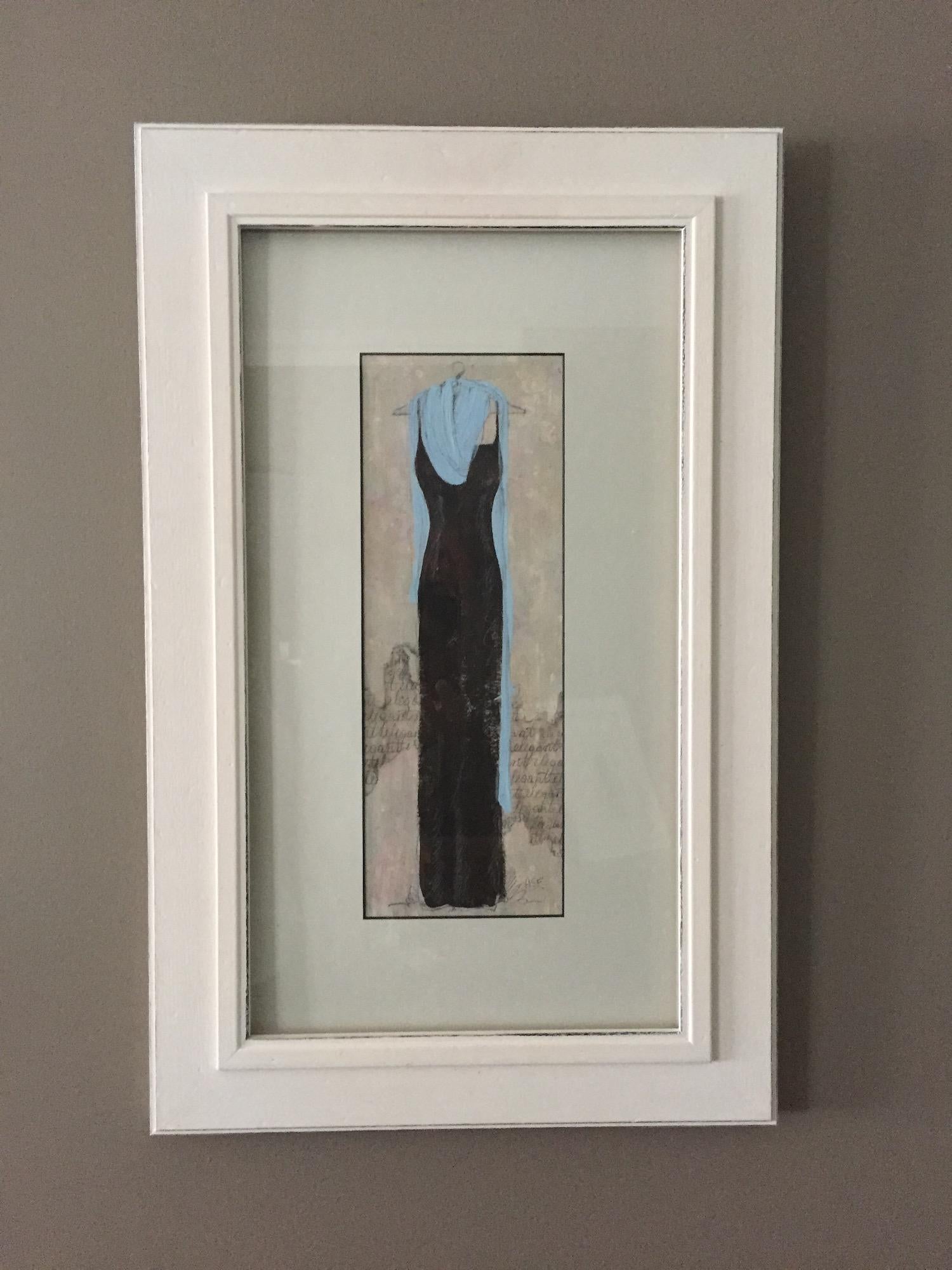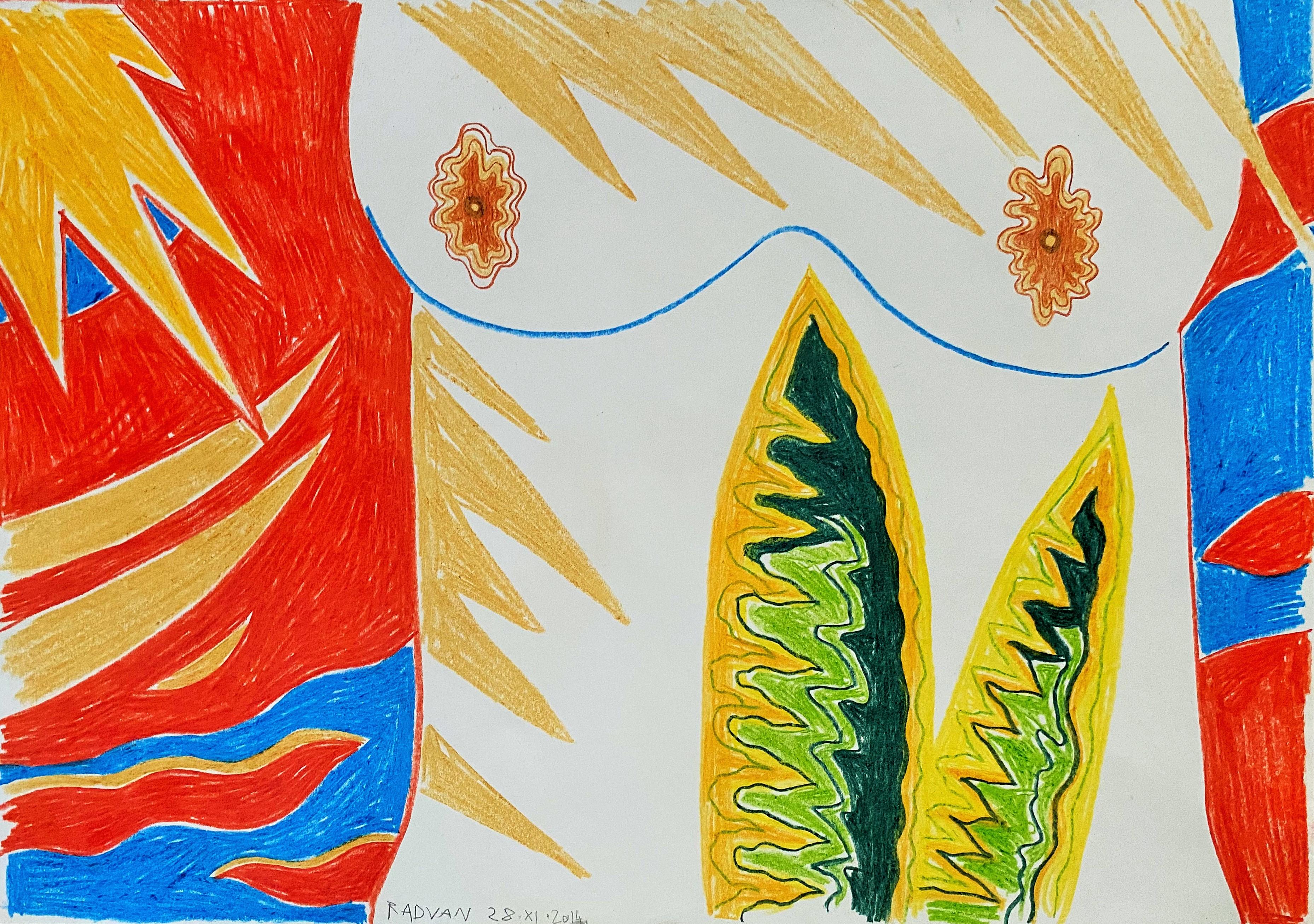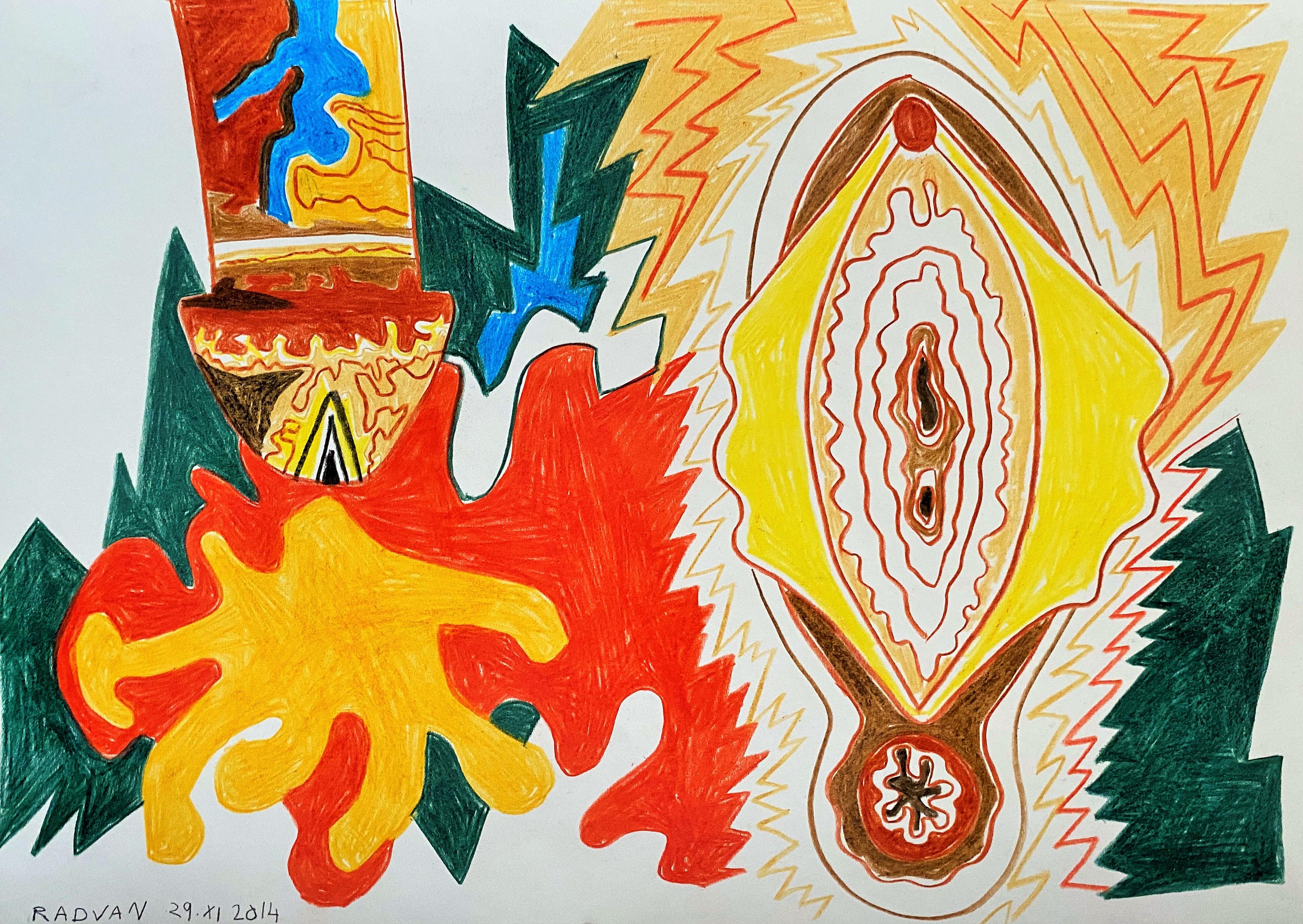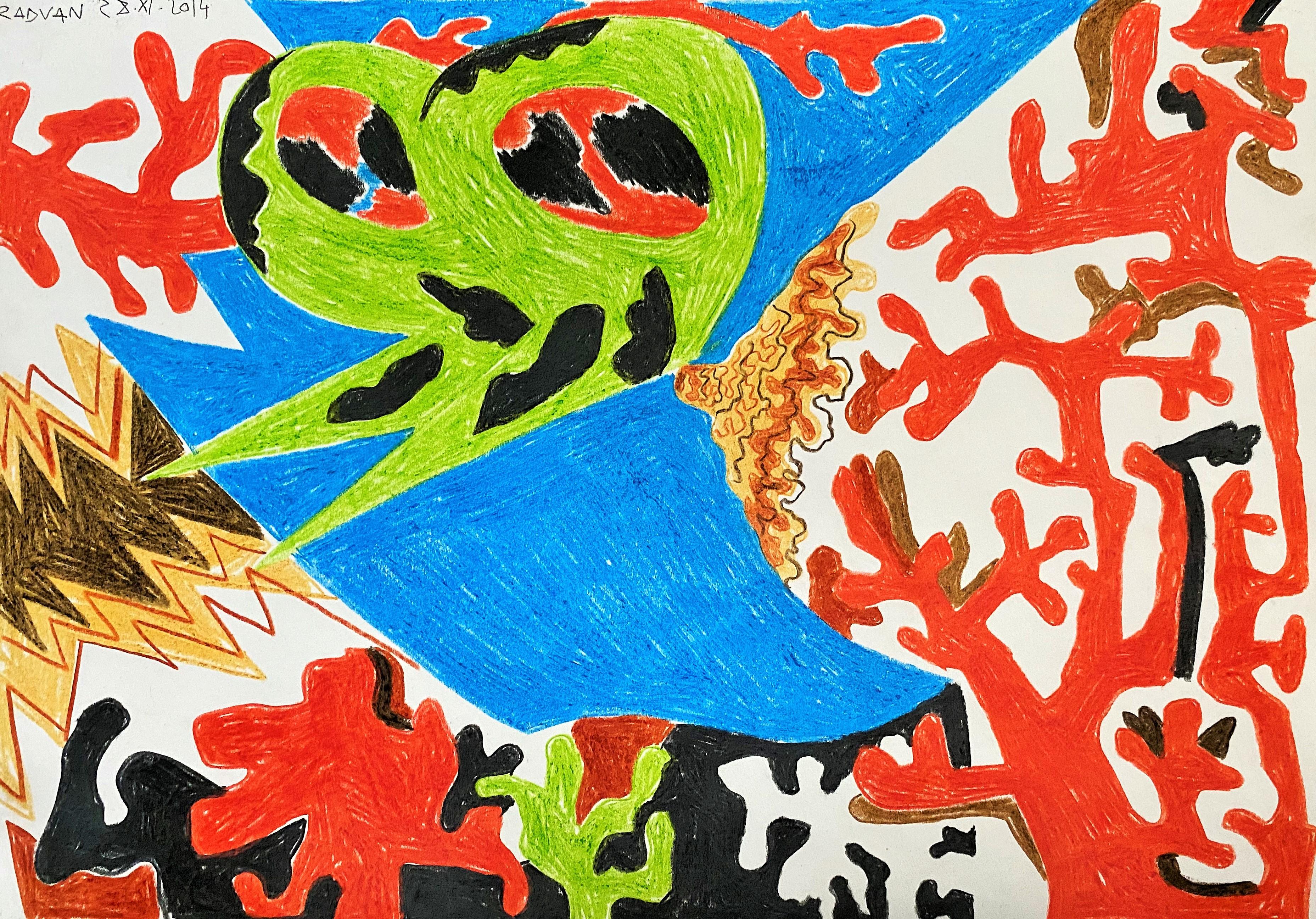Mary SpainTwo Boys (one standing, the other seated and drawing)1975
1975
About the Item
- Creator:Mary Spain (1934 - 1983, American)
- Creation Year:1975
- Dimensions:Height: 11.5 in (29.21 cm)Width: 13.75 in (34.93 cm)
- Medium:
- Movement & Style:
- Period:
- Condition:
- Gallery Location:Fairlawn, OH
- Reference Number:
Mary Spain
Mary Spain was born in Raleigh, North Carolina, in 1934. She studied art at Syracuse University and moved to Ohio in the 1960s to teach art at Chagrin Falls High School. She was a frequent exhibitor in the May Show at the Cleveland Museum of Art during the 1970s and early 1980s, where she won several Juror’s mentions for her paintings. Characteristic of her work is a flattened frontal gaze or a total profile view of her figures that recall Renaissance portraiture. Additionally, most of her characters are seen wearing odd or unusual hats. Spain believed that these hats identify the figures much like they do for professions such as chefs, clergy or law enforcement. The hats also act to contain the characters. While her figures often appear cute or innocent, Spain felt they were filled with mischief. Without their hats, she imagined that they might just explode. Spain’s interest in antique dolls and toys lends insight into the construction of her figures. Many figures have marionette-like qualities with blocky, out of proportion limbs, suggesting that perhaps they are not entirely in control of their actions. During her struggle with cancer, Spain used these figures to express her feelings of pain and sadness. While her deeply personal vocabulary and symbolism might be lost to the viewer, the narratives and embedded emotional substance remain.
- ShippingRetrieving quote...Ships From: Akron, OH
- Return PolicyA return for this item may be initiated within 10 days of delivery.
- Preliminary drawing for Remy de Gourmont, Couleurs, (Colors, new tales follow...By Jean-Emile LaboureurLocated in Fairlawn, OHPreliminary drawing for Remy de Gourmont, Couleurs, published in Le Mercure de France (Colors, new tales follow old things), 1908 Graphite and colored...Category
1920s Art Deco Figurative Drawings and Watercolors
MaterialsColor Pencil
- Untitled (Letitia, pregnant with Rising Sun)By Sedrick HuckabyLocated in Fairlawn, OHUntitled (Letitia, pregnant with Rising Sun) Graphite on paper, 2005 Signed: "Sedrick Huckaby III" lower right (see photo) In April 2008, Huckaby was awarded a Guggenheim fellowship for "stellar achievement and exceptional promise for continued accomplishment" Provenance: Valley House Gallery, the artist's dealer for many years Inv. #12949 Image size: 6 3/4 x 10 inches Sedrick Huckaby (b. 1975) Born in Fort Worth in 1975, Huckaby has been creating some form of art since his childhood. In 1995, he began his formal art studies at Texas Wesleyan University in Fort Worth. After a brief stay he transferred to Boston University, where he received a BFA degree. He then earned a MFA degree from Yale University in New Haven, Connecticut. Huckaby is known for his powerful use of color and his exploration of cultural roles and the heritage of the African American family. His work has evolved from portraiture to objects and interiors that venerate his personal family legacy rooted in Fort Worth, Texas. Portraying these familiar subjects on a large scale and pushing his use of materials, Huckaby defines the significance of family and tradition while touching on the subject of ethnographic stereotypes in our culture. For the past few years he has concentrated his efforts on a series of quilt paintings. One of the series he created is a tribute to both of his Grandmothers and a celebration of the African American quilting tradition. He used the actual quilts sewn by family members as models for his paintings. These quilts document significant events in his family history. According to Huckaby, the paintings represent an artistic family legacy. The colorful, rhythmic abstracted patterns come together like the musical notes in African American musician John Coltrane's famous jazz composition, A Love Supreme, from which the painting series acquired its name. He has earned national acclaim for his work over the past several years. Huckaby has received the 2001 Louis Comfort Tiffany Award...Category
Early 2000s Contemporary Figurative Drawings and Watercolors
MaterialsGraphite
- Road TripLocated in Fairlawn, OHSigned: Rudolf Lailson lower left Graphite, charcoal watercolor and pastelCategory
Early 2000s Contemporary Figurative Drawings and Watercolors
MaterialsGraphite
- red ballboy or Studies for "Tennis Tournament"By George Wesley BellowsLocated in Fairlawn, OHred ballboy or Studies for "Tennis Tournament" Unsigned Provenance: Estate of the Artist, 1925 Emma S. Bellows (widow( Emma S. Bellows Trust Allison Galleries, New York Representing the Bellows Trust. Stock HVA 34 Hirschl & Adler Galleries, New York Thomas French Fine Art Ronald Slotter, Columbus, Ohio Columbus College of Art and Design, de-accessed 2010 Annotated by the artist:"red ballboy" Study sketches...Category
1910s Ashcan School Figurative Drawings and Watercolors
MaterialsGraphite
- Untitled (Standing man with umbrella behind)By Charles MaurinLocated in Fairlawn, OHUntitled (Standing man with umbrella behind) Graphite on paper, c. 1890's Unsigned Provenance: Estate of the Artist Lucien Goldschmidt (1912-1992), noted art ...Category
1890s French School Figurative Drawings and Watercolors
MaterialsGraphite
- Preliminary study for Cretan Dancer bronze sculptureBy Boris Lovet-LorskiLocated in Fairlawn, OHPreliminary study for Cretan Dancer bronze sculpture Unsigned Graphite on tracing paper, 1930-1934 Sheet size: 6 7/8 x 7 1/8 inches Created while the artist was woring in Paris, c. 1930 “The stylizing of the Cretan allegories, used in figures of animals such as horses and bulls, symbolizes the ancient power of the South. These figures reveal a spiritual sensuality as he strives to attain a symbol of the earth and universe endowed with musical values. If man is the center of his idea of life and nature, it is because of the laws that govern the movement of stars and history. The link binding his figures together has, in a sense, a Pythagorean harmony.” Salvatore Quasimodo, Milan, 1967, quoted from Bush, Boris Lover-Lorski: The Language of Time, page 12. Regarding the artist: Boris Lovet-Lorski Lithuanian/Russian/American 1894-1973 Sculptor, painter, and printmaker, Boris Lovet-Lorski was born in Lithuania in 1894. His mother died when he was age three. His father was affluent and owned real estate. Boris grew up in a privileged environment. He studied architecture and then fine arts at the Imperial Academy of Art in Petrograd, Russia (now Saint Petersburg). Following the revolution in 1917 and its aftermath, Boris immigrated to Boston to live with his brother. In the 1920’s, his stylized, Art Deco inspired sculptures, lithographs, and paintings proved to be popular among the American elite. He exhibited frequently, holding his first solo exhibition in Boston, 1920. In the following years, Boris exhibited in New York at Marie Sterner Gallery, Jacques Seligmann Galleries and Wildenstein and Company. He lived in Paris from 1926 to 1932 where he befriended Joseph Hecht, and was exposed to the works of Pablo Picasso, Ossip Zadkine, Contantin Brancusi and Aristide Maillol. In 1932 he returned to America where he became a citizen later in the decade. Lovet-Lorski exhibited in the United States, South America, Europe and Asia. He was a member of the Society of Independent Artists (New York), the National Academy of Design (New York), and the Lotos Club (New York), as well as several Parisian salons. His work is in the permanent collections of numerous museums including the Musée Luxembourg, Bibliotèque Nationale, and the Petit Palais in France, the British Museum in London, the Metropolitan Museum in New York, the National Gallery in Washington, the Los Angeles County Museum of Art. (A more extensive list of his works in museums follows) He is considered one of the most successful and recognized sculptors of his generation. His creative influence can be seen in many of his contemporary artists. He died in Los Angeles in 1973. Regarding his iconic Art Deco sculptures of Cretan Dancers: “The stylizing of the Cretan allegories, used in figures of animals such as horses and bulls, symbolizes the ancient power of the South. These figures reveal a spiritual sensuality as he strives to attain a symbol of the earth and universe endowed with musical values. If man is the center of his idea of life and nature, it is because of the laws that govern the movement of stars and history. The link binding his figures together has, in a sense, a Pythagorean harmony.” Salvatore Quasimodo, Milan, 1967, quoted from Bush, Boris Lover-Lorski: The Language of Time, page 12. Lovet-Lorski created sculptures of the following major figures I.J. Paderewski, Prime Minister of Poland Arturo Toscanini, Italian Conductor Lilian Gish, Actress President Franklin D. Roosevelt Mrs. M. C. Niarchos, wife of Stavros Niarchos President Abraham Lincoln James Forrestal, Secretary of the Navy, First Secretary of Defense Pope Pius XII Dr. Albert Einstein, theoretical physicist President Dwight D. Eisenhower Albert Schweitzer, theologian, organist, writer, humanitarian, philosopher, and physician General Charles De Gaulle, President of the Fourth and Fifth Republic, France John Foster Dulles, Secretary of State, 1953-1959 President John F. Kennedy Works by Lover Lorski are in the following public collections: Albright-Knox Art Gallery, Buffalo Art Institute of Chicago Bibliotheque Nationale, Paris Brandeis University, Waltham, MA British Museum, London Boston University Brooklyn Museum California Palace of the Legion of Honor, Sam Francisco...Category
1930s Art Deco Figurative Drawings and Watercolors
MaterialsGraphite
- Classy Evening - (15"x 23", Framed Dress Painting)By Andrea Stajan-FerkulLocated in Mississauga, OntarioThis dress painting on board blends mediums to create textured detail with an outcome both expressive and refined. A scripted pencil pattern adds to the layers of tone on tone neutra...Category
2010s Contemporary Figurative Drawings and Watercolors
MaterialsBoard, Acrylic, Pencil, Color Pencil
- Rose Tattoo, Original DrawingLocated in Phoenix, AZRose Tattoo Luis Alfonso Jimenez 1940-2006 Original Drawing by Luis Jimenez, 1983. 22 x 30.25 inches. A stone lithograph edition was made from this drawing. There was a PBS documentary showing Jimenez drawing on the stone with the drawing in front of him and the making of the lithograph with Sette Publishing. Luis Alfonso Jimenez Born, 1940, El Paso, Texas, died 2006, Hondo, New Mexico. Statement: Luis Jimenez, in his work, celebrates the vitality of life. . . . Jimenez es un hijo de la frontera; he knows its people and the landscape. It is the transformation of these people into art that is his most important contribution to the art of this vast region which stretches between Mexico and the United States. His subject matter utilizes the popular images of the cultura del norte, and a large part of it is depicted and transformed in the rough and tumble world of la frontera. He is also a son of el norte, and so he uses its materials and explores its emerging, popular myths. The tension and attraction of Jimnez’s work is that he always creates within the space of his two worlds, the Mexicano and the Americano. He constantly shows us the irony of the two forces which repel, while showing us glimpses of the synthesis he seeks. What a gift it has been to us for this talented artist to reflect on the soul of our region. He gives meaning to our existence and history. Rudolfo Anaya (passage chosen by the artist), A View from La Frontera, Man on Fire: Luis Jimnez, pp. 1, 3, 6Biography: Luis Jimnez was born in Texas to parents who had emigrated from Mexico to the United States; he would later dedicate his 1989 sculpture Border Crossing to his father, who had entered the country illegally. The elder Jimnez was a neon sign designer in El Paso, and Luis worked with him as a youth. His experience working in the neon shop and his fascination with U.S. car culture would both become major influences on his art career. Jimenez studied architecture at the University of Texas, Austin (UTA), and also took art courses in which he first created sculptures with wood, steel, and fiberglass, choosing the latter because of its association with U.S. popular culture. He subsequently became one of the artists who made fiberglass an acceptable medium in the 1960s. In 1964 Jimenez received his B.S. in art from UTA, and he continued his studies at the Universidad Nacional Autnoma de Mexico in Mexico City. In 1966 he moved to New York City and worked as an assistant to sculptor Seymour Lipton. Jimnez began to exhibit his art while in New York and in 1972 moved to New Mexico to focus on creating public sculptures, even as he maintained his diverse output of drawings, prints, and lithographs. Drawing on his early experiences, Jimnez creates works that come from a border perspective, one that draws upon the hybridity bred by culture clashes. Often socially and politically informed, his works speak not only in regional terms, those germane to the southwestern United States, but to broader, more global issues as well. They exhibit a profoundly Chicano aesthetic and sensibility, one that is informed by Mexican and Mexican American traditions, North American popular culture, Chicano cultural icons, and images and themes unique to the Southwest. Death, sexuality, and the struggle of the common people are frequent themes. Inspired by authors who write in an autobiographical style, Jimnez creates works that function as personal narrative yet are also able to make statements about culture in more global terms. His use of bold colors and lines, a legacy from his fathers work as a neon sign maker, lends a dynamic sensuality to his work, one that is particularly evident in his monumental fiberglass and acrylic urethane sculptural works Many of Jimnezs works correspond to scholar Toms Ybarra-Fraustos definition of the Chicano aesthetic of rasquachismo, a lowbrow sensibility that appeals to the working class in that it applies to objects that subvert expressions of the mainstream or dominant culture. Creating art that speaks to the people, Jimnez is able to transform regional and culturally specific myths and symbols into globally recognized and relevant icons. Exhibitions: In addition to his personal work, Jimnez has been commissioned for numerous public art projects. In 1999 his sculpture Southwest Piet was designated a National Treasure by First Lady Hillary Clinton. The many exhibitions featuring his work have included Human Concern/Personal Torment (Whitney Museum of American Art, New York, 1969). The First International Motorcycle Art Show (Phoenix Art Museum, Phoenix, AZ, 1973). Three Texas Artists (Centre Cultural Americaine, USIS, Paris, 1977), Recent Trends in Collecting (Smithsonian Institution, Washington, DC, 1982). Committed to Print (Museum of Modern Art, New York, 1989) Printmaking in Texas: The 1980s (Modern Art Museum, Fort Worth, TX. Laguna Gloria Art Museum, Austin, 1990. The Whitney Biennial (Whitney Museum of American Art, New York, 1991) Man On Fire: Luis Jimnez (Albuquerque Museum of Art, NM, 1994-95). 47th Annual Purchase Exhibition (American Academy of Arts and Letters, New York, 1995). Traveling solo exhibition, Working Class Heroes: Images from the Popular Culture (1997-2000). Jiménez Collier Gallery has been in continuous operation for over 40 years. Originally located just off Main Street in downtown Scottsdale, Arizona, we have moved to Phoenix to accommodate and showcase our large inventory including: • Original works by Maynard Dixon, Lon Megargee, Ed Mell, Fritz Scholder, Bill Schenck, Bill Lesch, Luis Jimenez, Greg Singley, Dan Budnik, and other 20th century Western, WPA and Contemporary Southwestern artists. • The Fine Art Estate of Lon Megargee • Vintage rodeo photography...Category
1980s Contemporary Figurative Drawings and Watercolors
MaterialsMixed Media, Color Pencil
- Island for Umberto 08 - 21st Century, Drawing, Nude, Red, Yellow, Blue, SummerBy Alexandru RădvanLocated in Berlin, DEIsland for Umberto 08, 2014 Color pencil on paper ( Signed and dated front left corner, framed) 11.6 H x 16.5 W in. 29.5 H x 42 W cm "Island for Umberto" has the literary source in ...Category
2010s Contemporary Nude Drawings and Watercolors
MaterialsColor Pencil, Paper, Pencil
- Island for Umberto 10 - 21st Century, Drawing, Sun, Sea, Yellow, Orange, BlueBy Alexandru RădvanLocated in Berlin, DEIsland for Umberto 10, 2014 Colored pencil on paper ( Signed and dated front right corner, framed) 11.6 H x 16.5 W in. 29.5 H x 42 W cm "Island for Umberto" has the literary source ...Category
2010s Contemporary Figurative Drawings and Watercolors
MaterialsPaper, Color Pencil
- Island for Umberto 09 - Contemporary, Drawing, Nude, Summer, Red, YellowBy Alexandru RădvanLocated in Berlin, DEIsland for Umberto 09, 2014 Color pencil on paper ( Signed and dated front lower-left corner, framed) 11.6 H x 16.5 W in. 29.5 H x 42 W cm "Island for Umberto" has the literary sour...Category
2010s Contemporary Nude Drawings and Watercolors
MaterialsPaper, Color Pencil
- Island for Umberto 07 - Contemporary, Drawing, Red, Green, Blue, ButterfflyBy Alexandru RădvanLocated in Berlin, DEIsland for Umberto 07, 2014 Colored pencil on paper ( Signed and dated front left upper corner, framed) 11.6 H x 16.5 W in. 29.5 H x 42 W cm "Island for Umberto" has the literary so...Category
2010s Contemporary Landscape Drawings and Watercolors
MaterialsPaper, Pencil, Color Pencil






